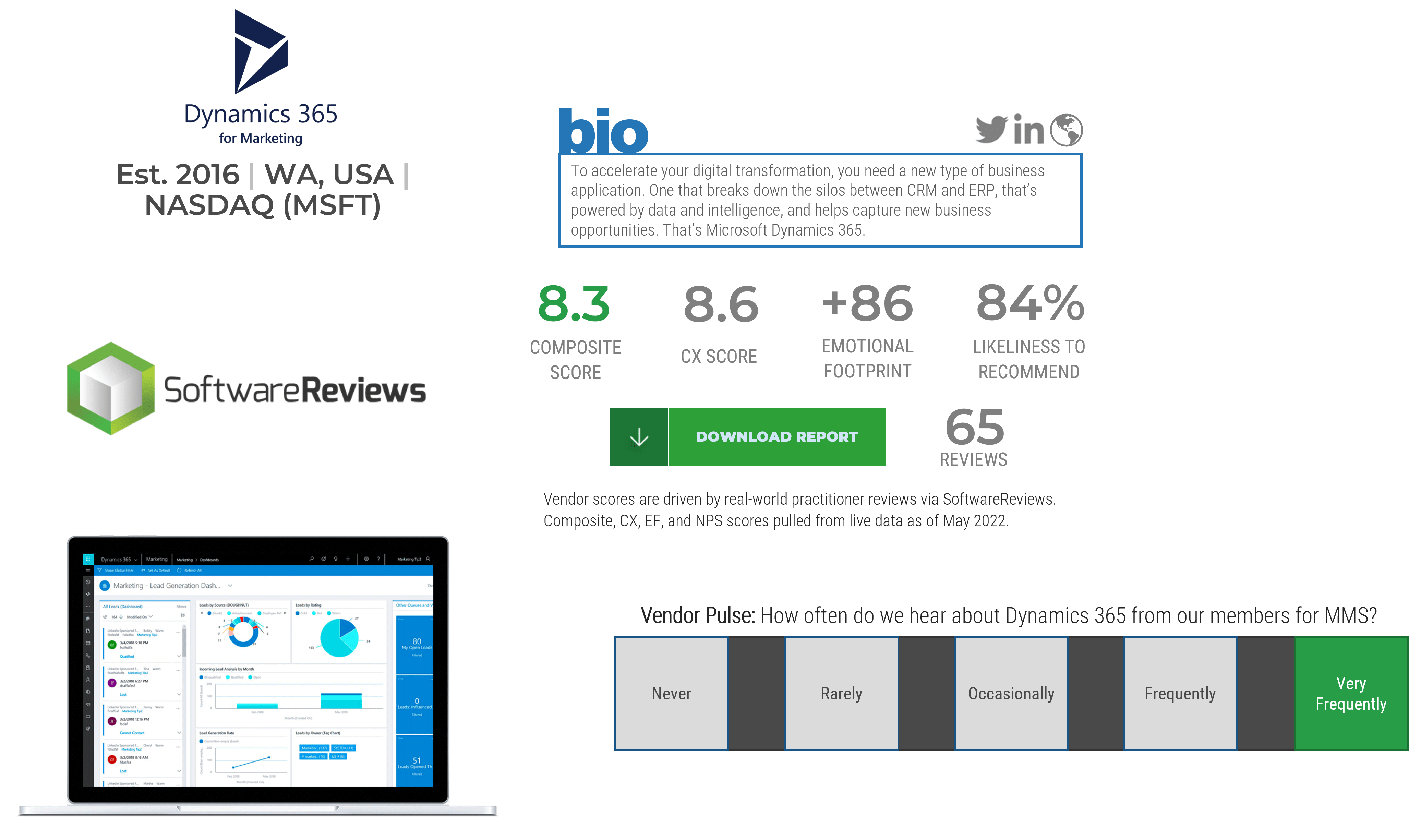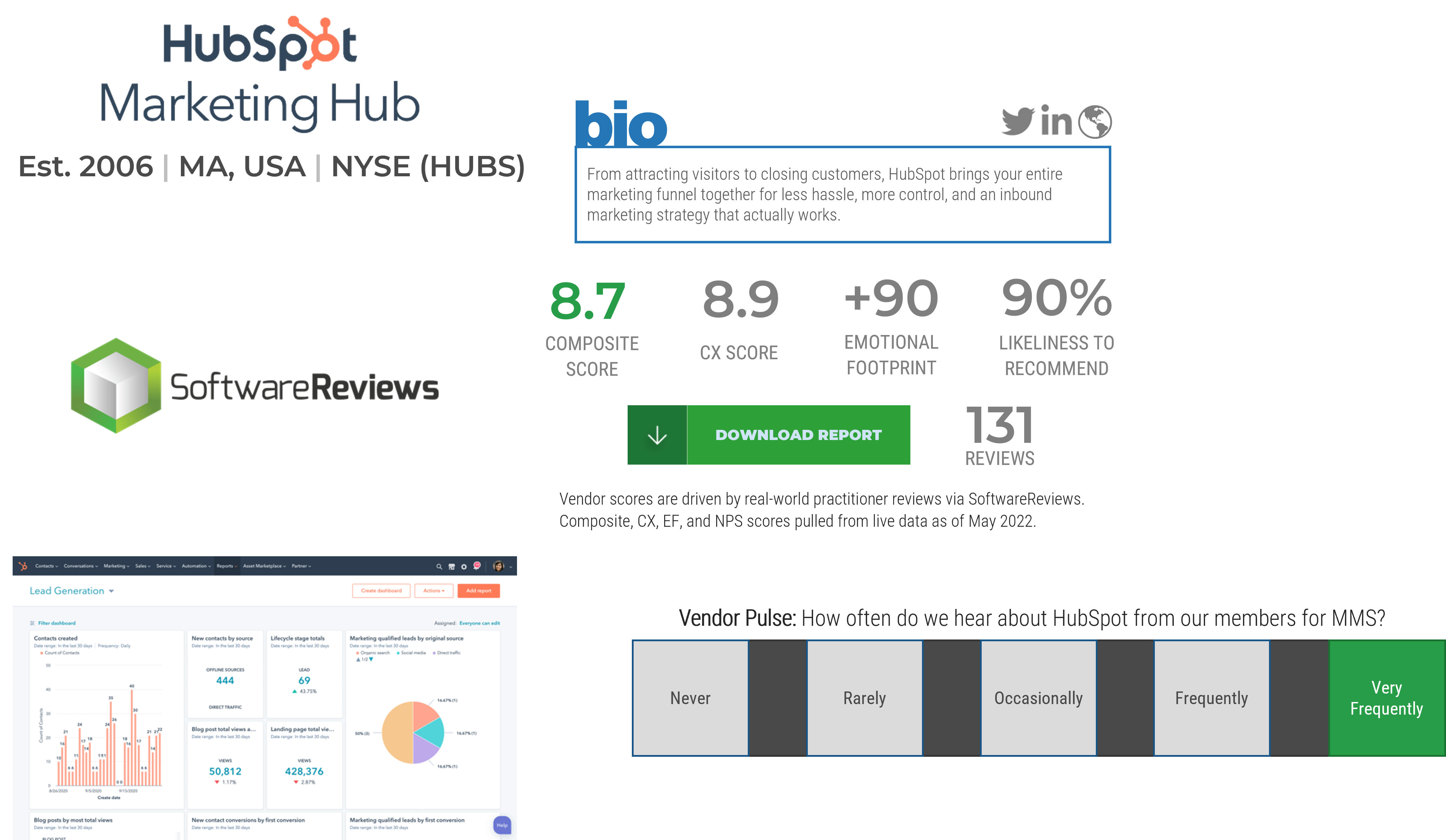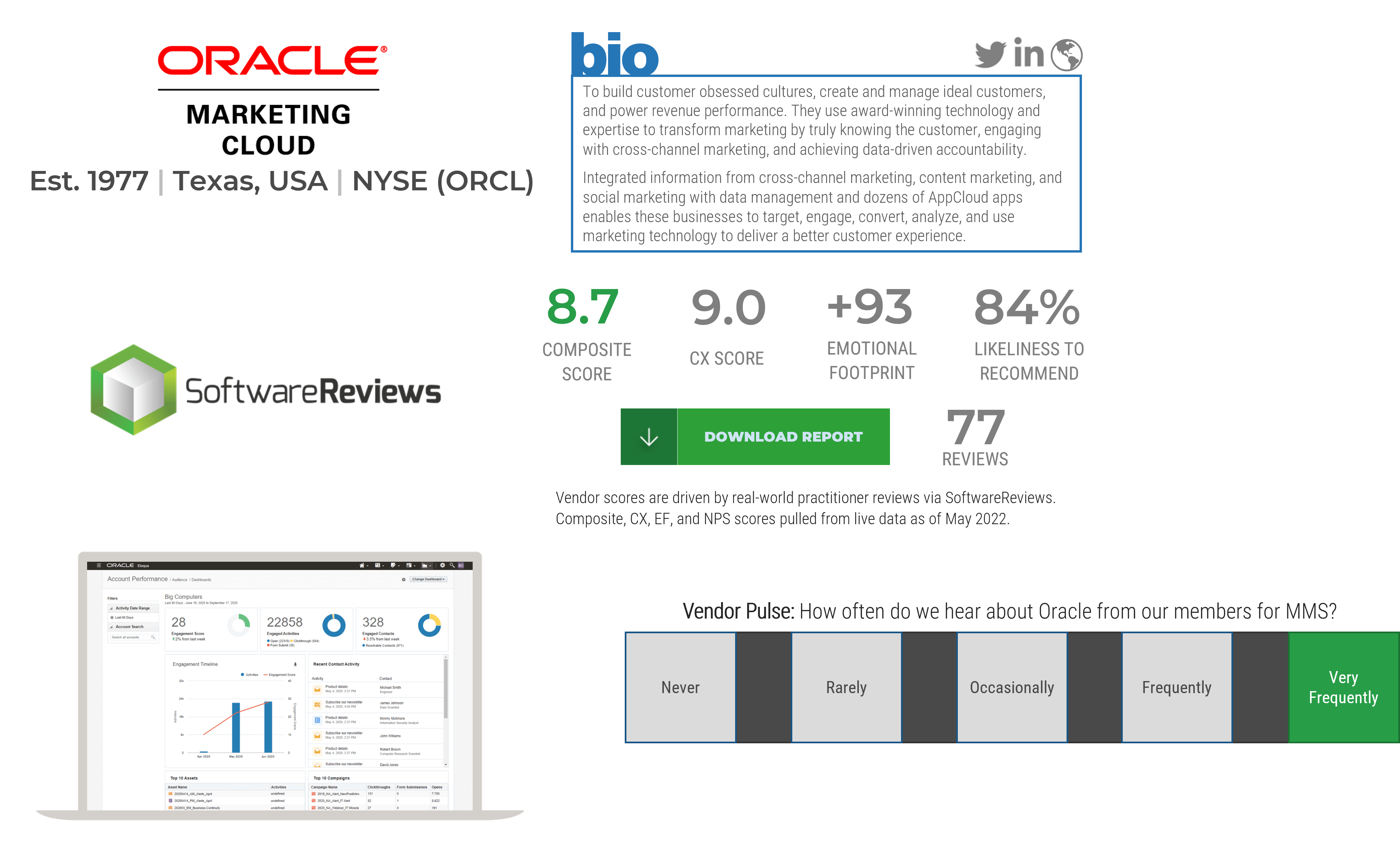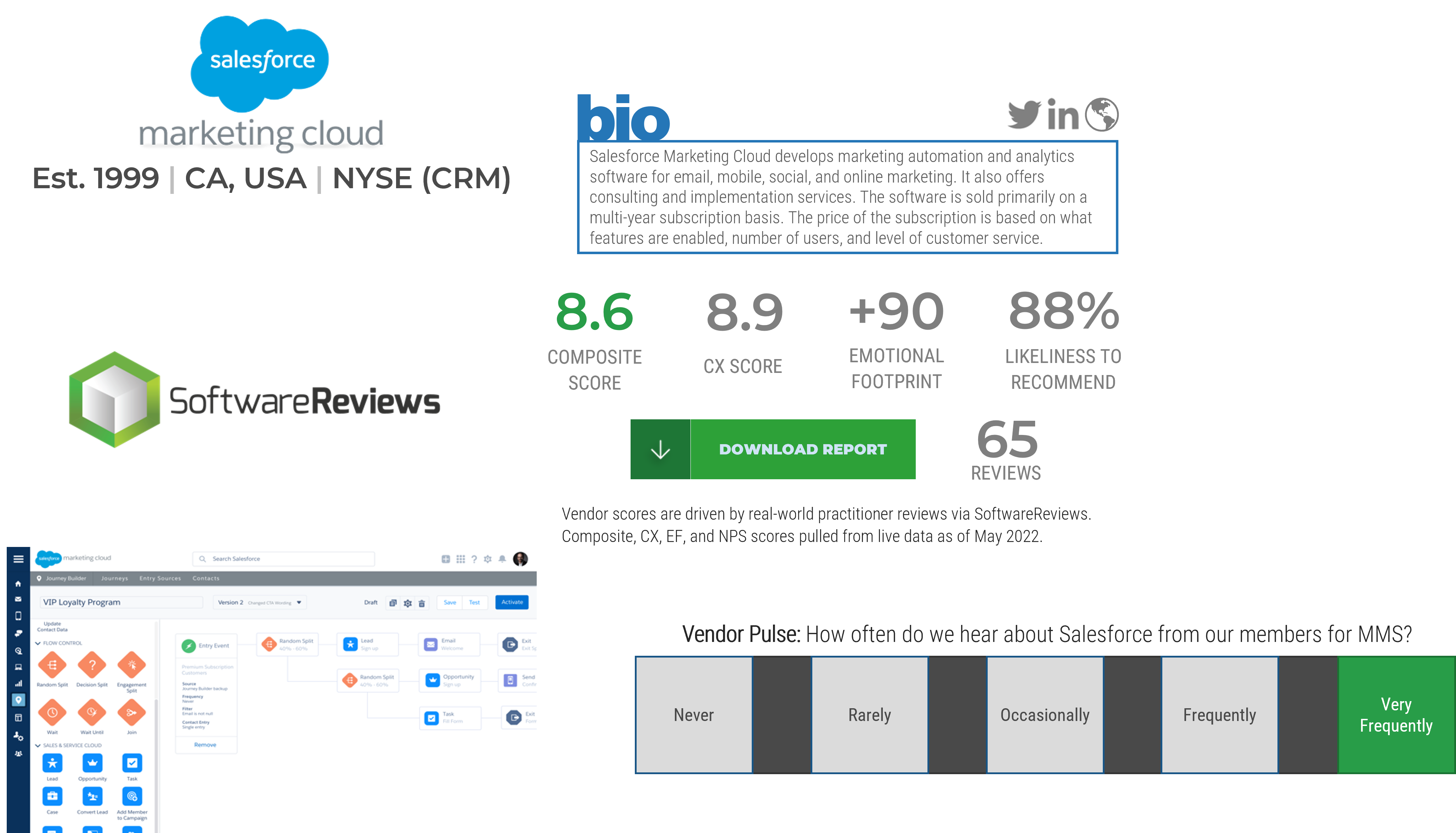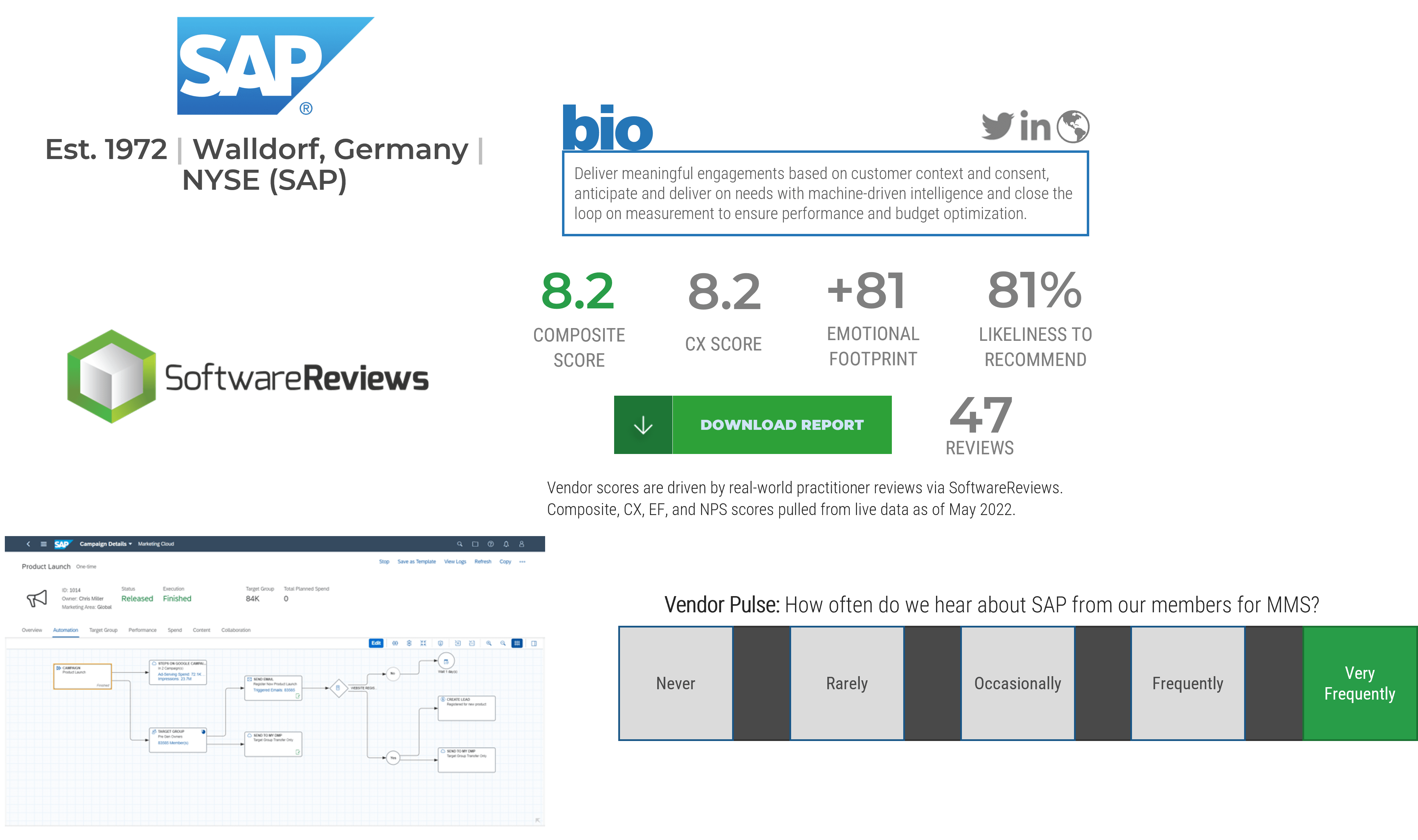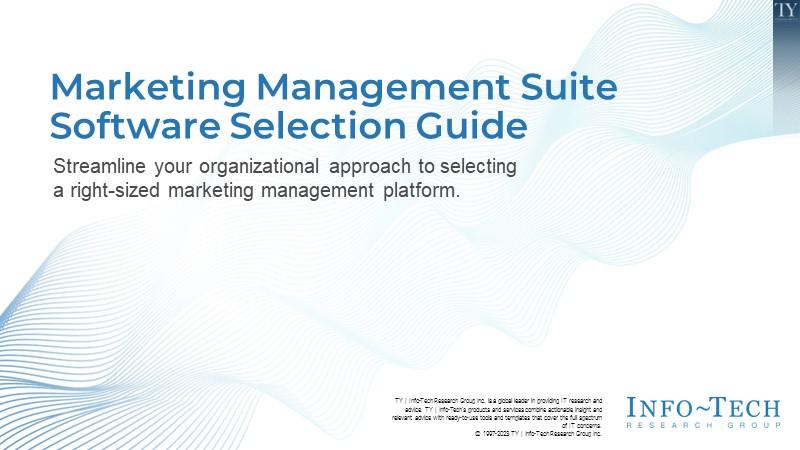
Marketing Management Suite Software Selection Guide
- Selecting and implementing the right MMS platform – one that aligns with your requirements – is a significant undertaking.
- Despite the importance of selecting and implementing the right MMS platform, many organizations struggle to define an approach to picking the most appropriate vendor and rolling out the solution in an effective and cost-efficient manner.
- IT often finds itself in the unenviable position of taking the fall for an MMS platform that doesn’t deliver on the promise of the MMS strategy.
Our Advice
Critical Insight
- MMS platform selection must be driven by your overall customer experience management strategy. Link your MMS selection to your organization’s CXM framework.
- Determine what exactly you require from your MMS platform; leverage use cases to help guide selection.
- Ensure strong points of integration between your MMS and other software such as CRM and POS. Your MMS solution should not live in isolation; it must be part of a wider ecosystem.
Impact and Result
- An MMS platform that effectively meets business needs and delivers value.
- Reduced costs during MMS vendor platform selection and faster time to results after implementation.
Marketing Management Suite Software Selection Guide Research & Tools
Besides the small introduction, subscribers and consulting clients within this management domain have access to:
1. Marketing Management Suite Software Selection Guide – A deck that walks you through the process of building your business case and selecting the proper MMS platform.
This blueprint will help you build a business case for selecting the right MMS platform, define key requirements, and conduct a thorough analysis and scan of the current state of the ever-evolving MMS market space.
- Marketing Management Suite Software Selection Guide Storyboard
Further reading
Marketing Management Suite Software Selection Guide
Streamline your organizational approach to selecting a right-sized marketing management platform.
Analyst perspective
A robustly configured and comprehensive MMS platform is a crucial ingredient to help kick-start your organization's cross-channel and multichannel marketing management initiatives.
Modern marketing management suites (MMS) are imperative given today's complex, multitiered, and often non-standardized marketing processes. Relying on isolated methods such as lead generation or email marketing techniques for executing key cross-channel and multichannel marketing initiatives is not enough to handle the complexity of contemporary marketing management activities.
Organizations need to invest in highly customizable and functionally extensive MMS platforms to provide value alongside the marketing value chain and a 360-degree view of the consumer's marketing journey. IT needs to be rigorously involved with the sourcing and implementation of the new MMS tool, and the necessary business units also need to own the requirements and be involved from the initial stages of software selection.
To succeed with MMS implementation, consider drafting a detailed roadmap that outlines milestone activities for configuration, security, points of integration, and data migration capabilities and provides for ongoing application maintenance and support.

Yaz Palanichamy
Senior Research Analyst, Customer Experience Strategy
Info-Tech Research Group
Executive summary
Your Challenge
- Many organizations struggle with taking a systematic and structured approach to selecting a right-sized marketing management suite (MMS) – an indispensable part of managing an organization's specific and nuanced marketing management needs.
- Organizations must define a clear-cut strategic approach to investing in a new MMS platform. Exercising the appropriate selection and implementation rigor for a right-sized MMS tool is a critical step in delivering concrete business value to sustain various marketing value chains across the organization.
Common Obstacles
- An MMS vendor that is not well aligned to marketing requirements wastes resources and causes an endless cascade of end-user frustration.
- The MMS market is rapidly evolving, making it difficult for vendors to retain a competitive foothold in the space.
- IT managers and/or marketing professionals often find themselves in the unenviable position of taking the fall for MMS platforms that fail to deliver on the promise of the overarching marketing management strategy.
Info-Tech's Approach
- MMS platform selection must be driven by your overall marketing management strategy. Email marketing techniques, social marketing, and/or lead management strategies are often not enough to satisfy the more sophisticated use cases demanded by increasingly complex customer segmentation levels.
- For organizations with a large audience or varied product offerings, a well-integrated MMS platform enables the management of various complex campaigns across many channels, product lines, customer segments, and marketing groups throughout the enterprise.
Info-Tech Insight
IT must collaborate with marketing professionals and other key stakeholder groups to define a unified vision and holistic outlook for a right-sized MMS platform.
Info-Tech's methodology for selecting a right-sized marketing management suite platform
| 1. Understand Core MMS Features |
2. Build the Business Case & Streamline Requirements |
3. Discover the MMS Market Space & Prepare for Implementation |
|
|---|---|---|---|
|
Phase Steps |
|
|
|
|
Phase Outcomes |
|
|
|
Guided Implementation
What does a typical GI on this topic look like?
| Phase 1 | Phase 2 | Phase 3 |
|---|---|---|
|
Call #1: Understand what a marketing management suite is. Discuss core capabilities and key trends. |
Call #2: Build the business case Call #3: Define your core Call #4: Build and sustain procurement vehicle best practices. |
Call #5: Evaluate the MMS vendor landscape and short-list viable options.
|
A Guided Implementation (GI) is a series of calls with an Info-Tech analyst to help implement our best practices in your organization.
The MMS procurement process should be broken into segments:
- Create a vendor shortlist using this buyer's guide.
- Define a structured approach to selection.
- Review the contract.
Info-Tech offers various levels of support to best suit your needs
DIY Toolkit
“Our team has already made this critical project a priority, and we have the time and capability, but some guidance along the way would be helpful.”
Guided Implementation
“Our team knows that we need to fix a process, but we need assistance to determine where to focus. Some check-ins along the way would help keep us on track.”
Workshop
“We need to hit the ground running and get this project kicked off immediately. Our team has the ability to take this over once we get a framework and strategy in place.”
Consulting
“Our team does not have the time or the knowledge to take this project on. We need assistance through the entirety of this project.”
Diagnostics and consistent frameworks used throughout all four options
EXECUTIVE BRIEF
What are marketing management suite platforms?
Our Definition: Marketing management suite (MMS) platforms are core enterprise applications that provide a unified set of marketing processes for a given organization and, typically, the capability to coordinate key cross-channel marketing initiatives.
Key product capabilities for sophisticated MMS platforms include but are not limited to:
- Email marketing
- Lead nurturing
- Social media management
- Content curation and distribution
- Marketing reporting and analytics
- Consistent brand messaging
Using a robust and comprehensive MMS platform equips marketers with the appropriate tools needed to make more informed decisions around campaign execution, resulting in better targeting, acquisition, and customer retention initiatives. Moreover, such tools can help bolster effective revenue generation and ensure more viable growth initiatives for future marketing growth enablement strategies.
Info-Tech Insight
Feature sets are rapidly evolving over time as MMS offerings continue to proliferate in this market space. Ensure that you focus on core components such as customer conversion rates and new lead captures through maintaining well- integrated multichannel campaigns.
Marketing Management Suite Software Selection Buyer's Guide
Info-Tech Insight
A right-sized MMS software selection and procurement decision should involve comprehensive requirements and needs analysis by not just Marketing but also other organizational units such as IT, in conjunction with input suppled from the internal vendor procurement team.

Phase 1
Understand Core MMS Features
Phase 1 |
Phase 2 |
Phase 3 |
|---|---|---|
|
1.1 Define MMS Platforms 1.2 Classify Table Stakes & Differentiating Capabilities 1.3 Explore Trends |
2.1 Build the Business Case 2.2 Streamline Requirements Elicitation 2.3 Develop an Inclusive RFP Approach |
3.1 Discover Key Players in the Vendor Landscape 3.2 Engage the Shortlist & Select Finalist 3.3 Prepare for Implementation |
This phase will walk you through the following activities:
- Level-set an understanding of MMS technology.
- Define which MMS features are table stakes (standard) and which are key differentiating functionalities.
- Identify the art of the possible in a modern MMS platform from sales, marketing, and service lenses.
This phase involves the following participants:
- CMO
- Digital Marketing Project Manager
- Marketing Data Analytics Analyst
- Marketing Management Executive
What are marketing management suite platforms?
Our Definition: Marketing management suite (MMS) platforms are core enterprise applications that provide a unified set of marketing processes for a given organization and, typically, the capability to coordinate key cross-channel marketing initiatives.
Key product capabilities for sophisticated MMS platforms include but are not limited to:
- Email marketing
- Lead nurturing
- Social media management
- Content curation and distribution
- Marketing reporting and analytics
- Consistent brand messaging
Using a robust and comprehensive MMS platform equips marketers with the appropriate tools needed to make more informed decisions around campaign execution, resulting in better targeting, acquisition, and customer retention initiatives. Moreover, such tools can help bolster effective revenue generation and ensure more viable growth initiatives for future marketing growth enablement strategies.
Info-Tech Insight
Feature sets are rapidly evolving over time as MMS offerings continue to proliferate in this market space. Ensure that you focus on core components such as customer conversion rates and new lead captures through maintaining well- integrated multichannel campaigns.
Marketing through the ages
Tracing the foundational origins of marketing management practices
Initial traction for marketing management strategies began with the need to holistically understand the effects of advertising efforts and how the media mix could be best optimized.
|
1902 |
1920s-1930s |
1942 |
1952-1964 |
1970s-1990s |
|---|---|---|---|---|
|
Recognizing the increasing need for focused and professional marketing efforts, the University of Pennsylvania offers the first marketing course, dubbed "The Marketing of Products." |
As broadcast media began to peak, marketers needed to manage a greater number of complex and interspersed marketing channels. |
The introduction of television ads in 1942 offered new opportunities for brands to reach consumers across a growing media landscape. To generate the highest ROI, marketers sought to understand the consumer and focus on more tailored messaging and product personalization. Thus, modern marketing practices were born. |
Following the introduction of broadcast media, marketers had to develop strategies beyond traditional spray-and-pray methods. The first modern marketing measurement concept, "marketing mix," was conceptualized in 1952 and popularized in 1964 by Neil Borden. |
This period marked the digital revolution and the new era of marketing. With the advent of new communications technology and the modern internet, marketing management strategies reached new heights of sophistication. During the early 1990s, search engines emerged to help users navigate the web, leading to early forms of search engine optimization and advertising. |
Where it's going: the future state of marketing management
- Increasing Complexity Driving
Consumer Purchasing Decisions
- "The main complexity is dealing with the increasing product variety and changing consumer demands, which is forcing marketers to abandon undifferentiated marketing strategies and even niche marketing strategies and to adopt a mass customization process interacting one-to-one with their customers." – Complexity, 2019
- Consumers Seeking More
Tailored Brand Personalization
- Financial Services marketers lead all other industries in AI application adoption, with 37% currently using them (Salesforce, 2019).
- The Inclusion of More AI-Enabled Marketing Strategies
- According to a 2022 Nostro report, 70% of consumers say it is important that brands continue to offer personalized consumer experiences.
- Green Marketing
- Recent studies have shown that up to 80% of all consumers are interested in green marketing strategies (Marketing Schools, 2020).
Marketing management by the numbers
Key trends
|
6% |
As a continuously growing discipline, marketing management roles are predicted to grow faster than average, at a rate of 6% over the next decade. Source: U.S. Bureau of Labor Statistics, 2021 |
|---|---|
|
17% |
While many marketing management vendors offer A/B testing, only 17% of marketers are actively using A/B testing on landing pages to increase conversion rates. Source: Oracle, 2022 |
|
70% |
It is imperative that technology and SaaS companies begin to use marketing automation as a core component of their martech strategy to remain competitive. About 70% of technology and SaaS companies are employing integrated martech tools. Source: American Marketing Association, 2021 |
Understand MMS table stakes features
Organizations can expect nearly all MMS vendors to provide the following functionality
|
Email Marketing |
Lead Nurturing |
Reporting, Analytics, and Marketing KPIs |
Marketing Campaign Management |
Integrational Catalog |
|---|---|---|---|---|
|
The use of email alongside marketing efforts to promote a business' products and services. Email marketing can be a powerful tool to maintain connections with your audience and ensure sustained brand promotion. |
The process of developing and nurturing relationships with key customer contacts at every major touchpoint in their customer journey. MMS platforms can use automated lead-nurturing functions that are triggered by customer behavior. |
The use of well-defined metrics to help curate, gather, and analyze marketing data to help track performance and improve the marketing department's future marketing decisions and strategies. |
Tools needed for the planning, execution, tracking, and analysis of direct marketing campaigns. Such tools are needed to help gauge your buyers' sentiments toward your company's product offerings and services. |
MMS platforms should generally have a comprehensive open API/integration catalog. Most MMS platforms should have dedicated integration points to interface with various tools across the marketing landscape (e.g. social media, email, SEO, CRM, CMS tools, etc.). |
Identify differentiating MMS features
While not always deemed must-have functionality, these features may be the deciding factor when choosing between two MMS-focused vendors.
|
Digital Asset Management (DAM) |
A DAM can help manage digital media asset files (e.g. photos, audio files, video). |
|---|---|
|
Customer Data Management |
Customer data management modules help your organization track essential customer information to maximize your marketing results. |
|
Text-Based Marketing |
Text-based marketing strategy is ideal for any organization primarily focused on coordinating structured and efficient marketing campaigns. |
|
Customer |
Customer journey orchestration enables users to orchestrate customer conversations and journeys across the entire marketing value chain. |
|
AI-Driven Workflows |
AI-powered workflows can help eliminate complexities and allow marketers to automate and optimize tasks across the marketing spectrum. |
|
Dynamic Segmentation |
Dynamic segmentation to target audience cohorts based on recent actions and stated preferences. |
|
Advanced Email Marketing |
These include capabilities such as A/B testing, spam filter testing, and detailed performance reporting. |
Ensure you understand the art of the possible across the MMS landscape
Understanding the trending feature sets that encompass the broader MMS vendor landscape will best equip your organization with the knowledge needed to effectively match today's MMS platforms with your organization's marketing requirements.
Holistically examine the potential of any MMS solution through three main lenses:
|
Data-Driven |
Adapt innovative techniques such as conversational marketing to help collect, analyze, and synthesize crucial audience information to improve the customer marketing experience and pre-screen prospects in a more conscientious manner. |
|---|---|
|
Next Best Action Marketing |
Next best action marketing (NBAM) is a customer-centric paradigm/marketing technique designed to capture specific information about customers and their individual preferences. Predicting customers' future actions by understanding their intent during their purchasing decisions stage will help improve conversion rates. |
|
AI-Driven Customer |
The use of inclusive and innovative AI-based forecast modeling techniques can help more accurately analyze customer data to create more targeted segments. As such, marketing messages will be more accurately tailored to the customer that is reading them. |
Art of the possible: data-driven digital advertising
CONVERSATIONAL MARKETING INTELLIGENCE
Are you curious about the measures needed to boost engagement among your client base and other primary target audience groups? Conversational marketing intelligence metrics can help collect and disseminate key descriptive data points across a broader range of audience information.
AI-DRIVEN CONVERSATIONAL MARKETING DEVICES
Certain social media channels (e.g. LinkedIn and Facebook) like to take advantage of click-to-Messenger-style applications to help drive meaningful conversations with customers and learn more about their buying preferences. In addition, AI-driven chatbot applications can help the organization glean important information about the customer's persona by asking probing questions about their marketing purchase behaviors and preferences.
METAVERSE- DRIVEN BRANDING AND ADVERTISING
One of the newest phenomena in data-driven marketing technology and digital advertising techniques is the metaverse, where users can represent themselves and their brand via virtual avatars to further gamify their marketing strategies. Moreover, brands can create immersive experiences and engage with influencers and established communities and collect a wealth of information about their audience that can help drive customer retention and loyalty.
Case study

Metaverse marketing extends the potential for commercial brand development and representation: a deep dive into Gucci's metaverse practice
INDUSTRY: Luxury Goods Apparel
SOURCE: Vogue Business
Challenge
Beginning with a small, family-owned leather shop known as House of Gucci in Florence, Italy, businessman and fashion designer Guccio Gucci sold saddles, leather bags, and other accessories to horsemen during the 1920s. Over the years, Gucci's offerings have grown to include various other personal luxury goods.
As consumer preferences have evolved over time, particularly with the younger generation, Gucci's professional marketing teams looked to invest in virtual technology environments to help build and sustain better brand awareness among younger consumer audiences.
Solution
In response to the increasing presence of metaverse-savvy gamers on the internet, Gucci began investing in developing its online metaverse presence to bolster its commercial marketing brand there.
A recent collaboration with Roblox, an online gaming platform that offers virtual experiences, provided Gucci the means to showcase its fashion items using the Gucci Garden – a virtual art installation project for Generation Z consumers, powered by Roblox's VR technology. The Gucci Garden virtual system featured a French-styled garden environment where players could try on and buy Gucci virtual fashion items to dress up their blank avatars.
Results
Gucci's disruptive, innovative metaverse marketing campaign project with Roblox is proof of its commitment to tapping new marketing growth channels to showcase the brand to engage new and prospective consumers (e.g. Roblox's player base) across more unique sandboxed/simulation environments.
The freedom and flexibility in the metaverse environments allows brands such as Gucci to execute a more flexible digital marketing approach and enables them to take advantage of innovative metaverse-driven technologies in the market to further drive their data-driven digital marketing campaigns.
Art of the possible: next best action marketing (NBAM)
NEXT BEST ACTION PREDICTIVE MODELING
To improve conversion propensity, next best action techniques can use predictive modeling methods to help build a dynamic overview of the customer journey. With information sourced from actionable marketing intelligence data, MMS platforms can use NBAM techniques to identify customer needs based on their buying behavior, social media interactions, and other insights to determine what unique set of actions should be taken for each customer.
MACHINE LEARNING–BASED RECOMMENDER SYSTEMS
Rules-based recommender systems can help assign probabilities of purchasing behaviors based on the patterns in touchpoints of a customer's journey and interaction with your brand. For instance, a large grocery chain company such as Walmart or Whole Foods will use ML-based recommender systems to decide what coupons they should offer to their customers based on their purchasing history.
Art of the possible: AI-driven customer segmentation
MACHINE/DEEP LEARNING (ML/DL) ALGORITHMS
The inclusion of AI in data analytics helps make customer targeting more accurate
and meaningful. Organizations can analyze customer data more thoroughly and generate in-depth contextual and descriptive information about the targeted segments. In addition, they can use this information to automate the personalization of marketing campaigns for a specific target audience group.
UNDERSTANDING CUSTOMER SENTIMENTS
To greatly benefit from AI-powered customer segmentation, organizations must deploy specialized custom AI solutions to help organize qualitative comments into quantitative data. This approach requires companies to use custom AI models and tools that will analyze customer sentiments and experiences based on data extracted from various touchpoints (e.g. CRM systems, emails, chatbot logs).
Phase 2
Build the Business Case and Streamline Requirements
Phase 1 | Phase 2 | Phase 3 |
|---|---|---|
1.1 Define MMS Platforms 1.2 Classify Table Stakes & Differentiating Capabilities 1.3 Explore Trends | 2.1 Build the Business Case 2.2 Streamline Requirements Elicitation 2.3 Develop an Inclusive RFP Approach | 3.1 Discover Key Players in the Vendor Landscape 3.2 Engage the Shortlist & Select Finalist 3.3 Prepare for Implementation |
This phase will walk you through the following activities:
- Define and build the business case for the selection of a right-sized MMS platform.
- Elicit and prioritize granular requirements for your MMS platform.
This phase involves the following participants:
- CMO
- Technical Marketing Analyst
- Digital Marketing Project Manager
- Marketing Data Analytics Analyst
- Marketing Management Executive
Software Selection Engagement
5 Advisory Calls over a 5-Week Period to Accelerate Your Selection Process
Expert analyst guidance over 5 weeks on average to select software and negotiate with the vendor.
Save money, align stakeholders, speed up the process and make better decisions.
Use a repeatable, formal methodology to improve your application selection process.
Better, faster results, guaranteed, included in your membership.
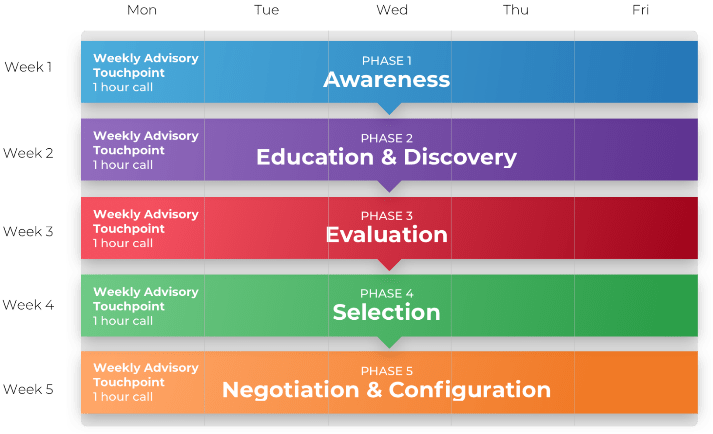
CLICK HERE to book your Selection Engagement
Elicit and prioritize granular requirements for your marketing management suite (MMS) platform
Understanding business needs through requirements gathering is the key to defining everything you need from your software. However, it is an area where people often make critical mistakes.
|
Poorly scoped requirements |
Best practices |
|---|---|
|
|
Info-Tech Insight
Poor requirements are the number one reason projects fail. Review Info-Tech's Improve Requirements Gathering blueprint to learn how to improve your requirements analysis and get results that truly satisfy stakeholder needs.
Info-Tech's approach
Develop an inclusive and thorough approach to the RFP process

Info-Tech Insight
Review Info-Tech's process and understand how you can prevent your organization from leaking negotiation leverage while preventing vendors from taking control of your RFP.
The Info-Tech difference:
- The secret to managing an RFP is to make it as manageable and as thorough as possible. The RFP process should be like any other aspect of business – by developing a standard process. With a process in place, you are better able to handle whatever comes your way, because you know the steps you need to follow to produce a top-notch RFP.
- The business then identifies the need for more information about a product/service or determines that a purchase is required.
- A team of stakeholders from each area impacted gather all business, technical, legal, and risk requirements. What are the expectations of the vendor relationship post-RFP? How will the vendors be evaluated?
- Based on the predetermined requirements, either an RFI or an RFP is issued to vendors with a due date.
Leverage Info-Tech's Contract Review Service to level the playing field with your shortlisted vendors
You may be faced with multiple products, services, master service agreements, licensing models, service agreements, and more.
Use Info-Tech's Contract Review Service to gain insights on your agreements:
- Are all key terms included?
- Are they applicable to your business?
- Can you trust that results will be delivered?
- What questions should you be asking from an IT perspective?
Validate that a contract meets IT's and the business' needs by looking beyond the legal terminology. Use a practical set of questions, rules, and guidance to improve your value for dollar spent.
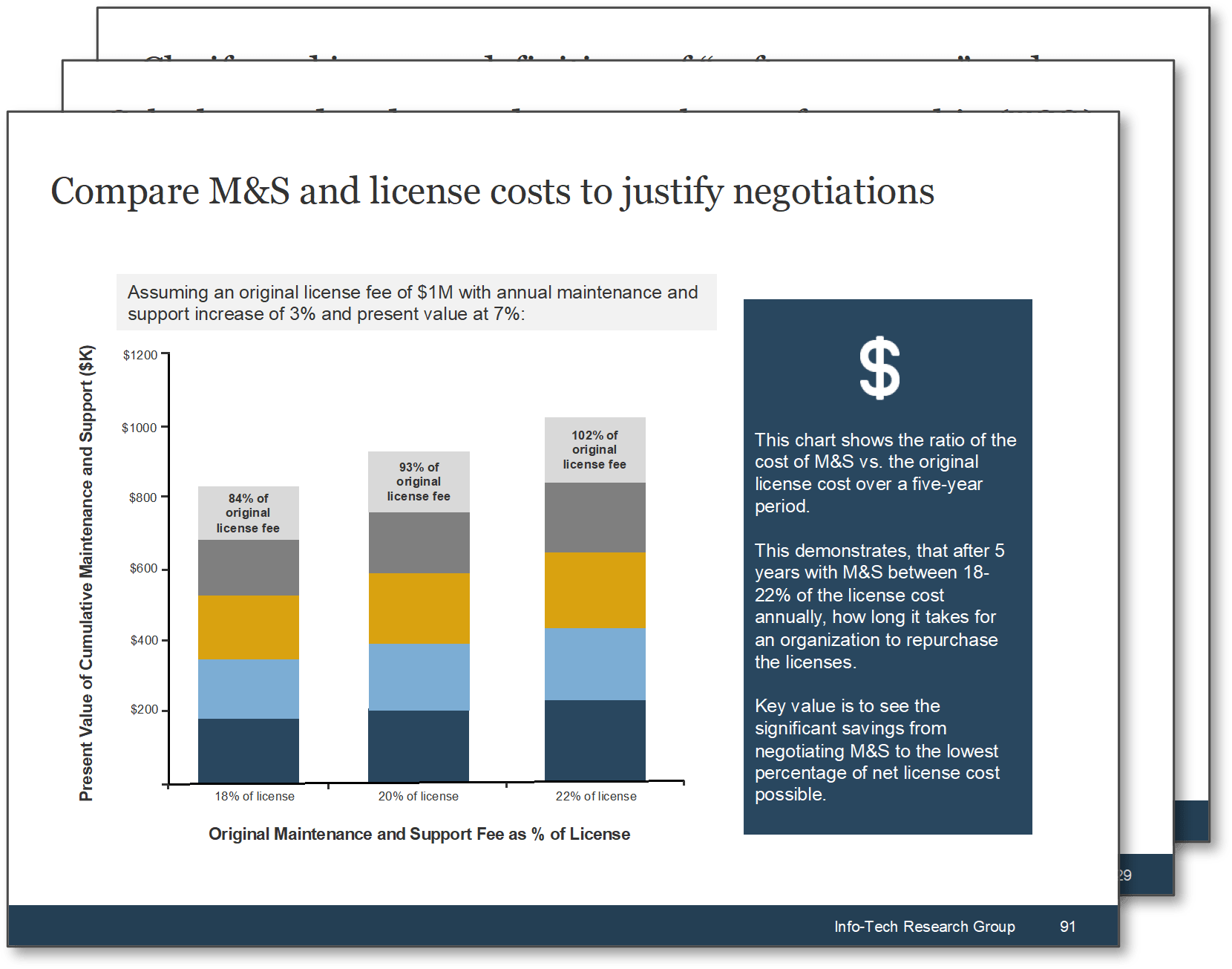
CLICK to BOOK The Contract Review Service
CLICK to DOWNLOAD Master Contract Review and Negotiation for Software Agreements
Phase 3
Discover the MMS Market Space and Prepare for Implementation
Phase 1 | Phase 2 | Phase 3 |
|---|---|---|
1.1 Define MMS Platforms 1.2 Classify Table Stakes & Differentiating Capabilities 1.3 Explore Trends | 2.1 Build the Business Case 2.2 Streamline Requirements Elicitation 2.3 Develop an Inclusive RFP Approach | 3.1 Discover Key Players in the Vendor Landscape 3.2 Engage the Shortlist & Select Finalist 3.3 Prepare for Implementation |
This phase will walk you through the following activities:
- Dive into the key players of the MMS vendor landscape.
- Understand best practices for building a vendor shortlist.
- Understand key implementation considerations for MMS.
This phase involves the following participants:
- CMO
- Marketing Management Executive
- Applications Manager
- Digital Marketing Project Manager
- Sales Executive
- Vendor Outreach and Partnerships Manager
Review your use cases to start your shortlist
Your Info-Tech analysts can help you narrow down the list of vendors that will meet your requirements.
Next steps will include:
- Reviewing your requirements.
- Checking out SoftwareReviews.
- Shortlisting your vendors.
- Conducting demos and detailed proposal reviews.
- Selecting and contracting with a finalist!
Get to know the key players in the MMS landscape
The following slides provide a top-level overview of the popular players you will encounter in your MMS shortlisting process.
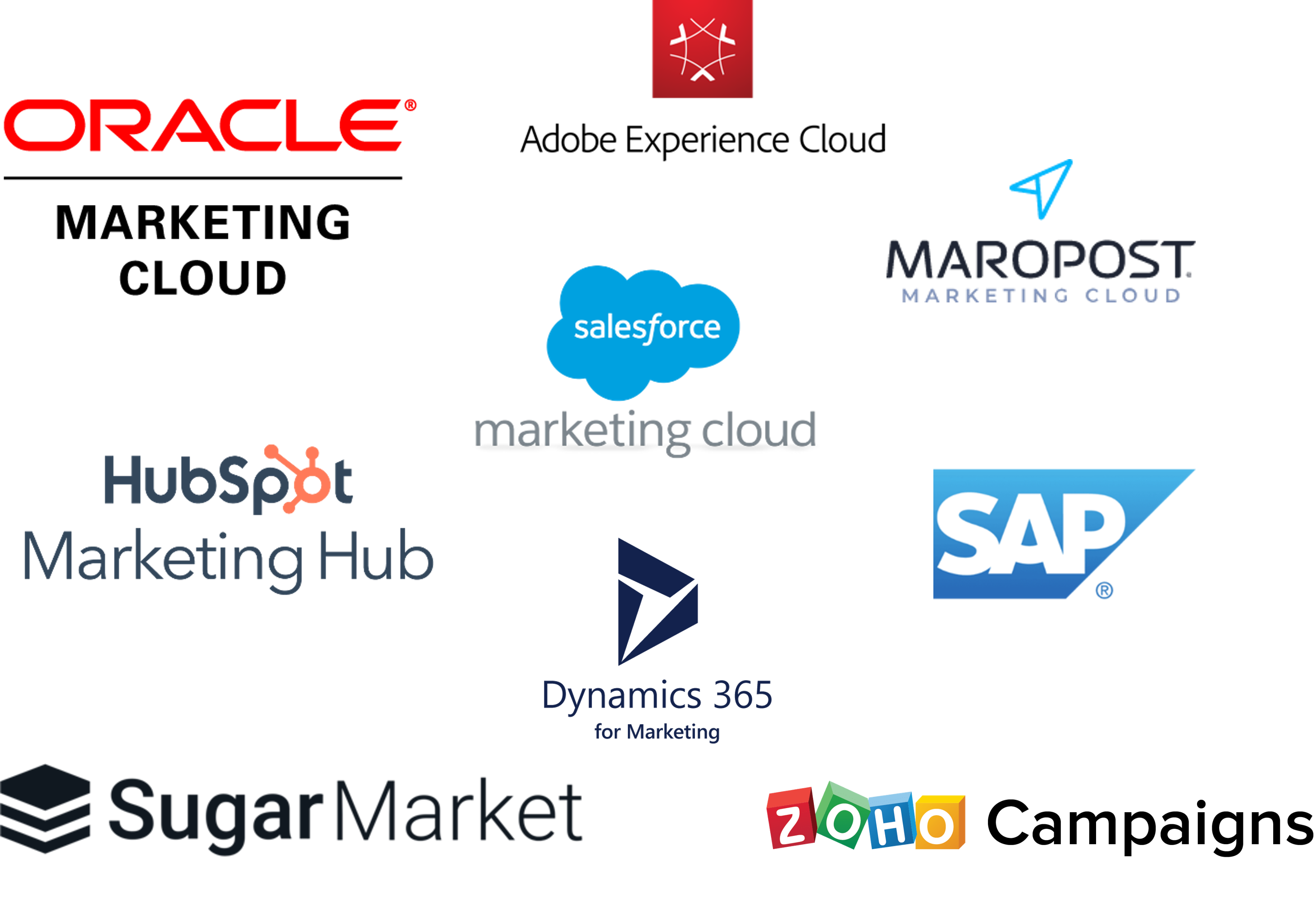
Evaluate software category leaders through vendor rankings and awards
SoftwareReviews
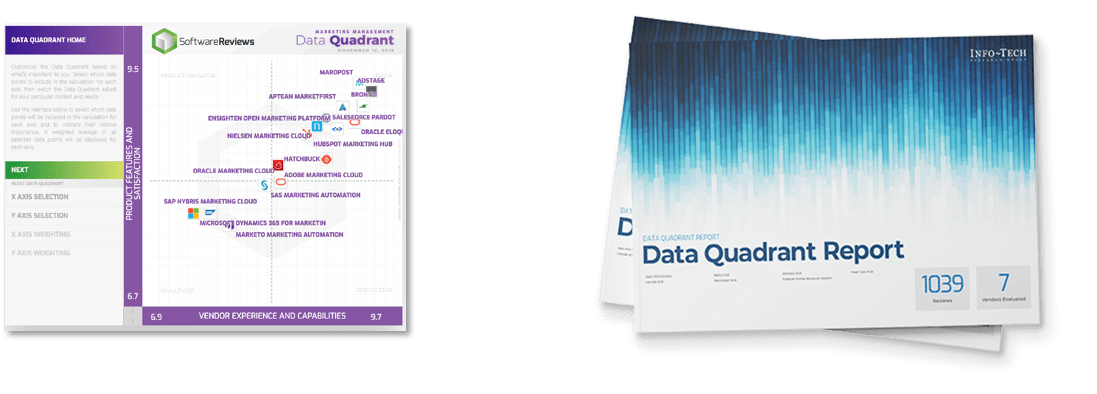
|
The Data Quadrant is a thorough evaluation and ranking of all software in an individual category to compare platforms across multiple dimensions. Vendors are ranked by their Composite Score, based on individual feature evaluations, user satisfaction rankings, vendor capability comparisons, and likeliness to recommend the platform. |
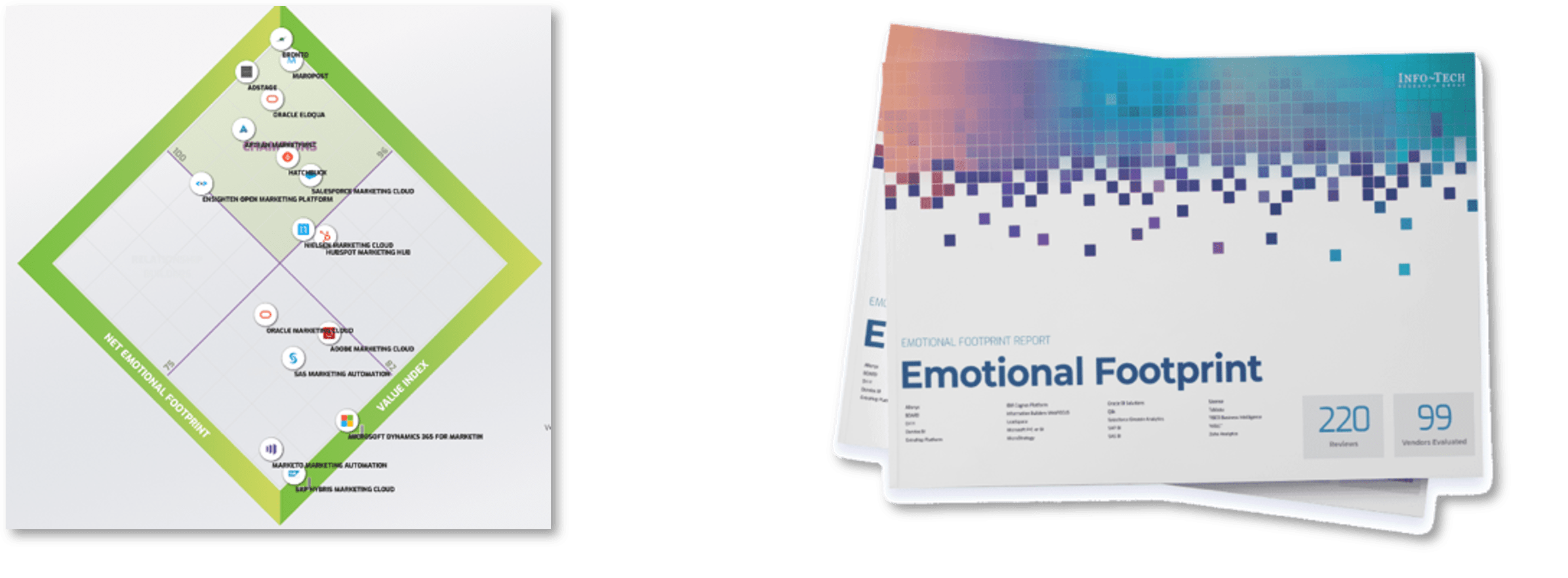
|
The Emotional Footprint is a powerful indicator of overall user sentiment toward the relationship with the vendor, capturing data across five dimensions. Vendors are ranked by their Customer Experience (CX) Score, which combines the overall Emotional Footprint rating with a measure of the value delivered by the solution. |
Speak with category experts to dive deeper into the vendor landscape
SoftwareReviews
- Fact-based reviews of business software from IT professionals.
- Product and category reports with state-of-the-art data visualization.
- Top-tier data quality backed by a rigorous quality assurance process.
- User-experience insight that reveals the intangibles of working with a vendor.
CLICK HERE to ACCESS |
|---|
|
Comprehensive software reviews
|
|
We collect and analyze the most detailed reviews on enterprise software from real users to give you an unprecedented view into the product and vendor before you buy. |
SoftwareReviews is powered by Info-Tech
Technology coverage is a priority for Info-Tech, and SoftwareReviews provides the most comprehensive unbiased data on today's technology. Combined with the insight of our expert analysts, our members receive unparalleled support in their buying journey.
SoftwareReviews' Enterprise MMS Rankings
Strengths:
- Advanced Campaign Management
- Email Marketing Automation
- Multichannel Integration
Areas to Improve:
- Mobile Marketing Management
- Advanced Data Segmentation
- Pricing Sensitivity and Implementation Support Model
history

"Adobe Experience Cloud (AEC), formerly Adobe Marketing Cloud (AMC), provides a host of innovative multichannel analytics, social, advertising, media optimization, and content management products (just to name a few). The Adobe Marketing Cloud package allows users with valid subscriptions to download the entire collection and use it directly on their computer with open access to online updates. Organizations that have a deeply ingrained Adobe footprint and have already reaped the benefits of Adobe's existing portfolio of cloud services products (e.g. Adobe Creative Cloud) will find the AEC suite a functionally robust and scalable fit for their marketing management and marketing automation needs.
However, it is important to note that AEC's pricing model is expensive when compared to other competitors in the space (e.g. Sugar Market) and, therefore, is not as affordable for smaller or mid-sized organizations. Moreover, there is the expectation of a learning curve with the AEC platform. Newly onboarded users will need to spend some time learning how to navigate and work comfortably with AEC's marketing automaton modules. "
-
Yaz Palanichamy
Senior Research Analyst, Info-Tech Research Group
Adobe Experience Cloud Platform pricing is opaque.
Request a demo.*
*Info-Tech recommends reaching out to the vendor's internal sales management team for explicit details on individual pricing plans for the Adobe Marketing Cloud suite.
| 2021 |
Adobe Experience Platform Launch is integrated into the Adobe Experience Platform as a suite of data collection technologies (Experience League, Adobe). |
|---|---|
| November 2020 |
Adobe announces that it will spend $1.5 billion to acquire Workfront, a provider of marketing collaboration software (TechTarget, 2020). |
|
September 2018 |
Adobe acquires marketing automation software company Marketo (CNBC, 2018). |
| June 2018 |
Adobe buys e-commerce services provider Magento Commerce from private equity firm Permira for $1.68 billion (TechCrunch, 2018). |
| 2011 |
Adobe acquires DemDex, Inc. with the intention of adding DemDex's audience-optimization software to the Adobe Online Marketing Suite (Adobe News, 2011). |
| 2009 |
Adobe acquires online marketing and web analytics company Omniture for $1.8 billion and integrates its products into the Adobe Marketing Cloud (Zippia, 2022). |
|
Adobe platform launches in December 1982. |
|
SoftwareReviews' Enterprise MMS Rankings
Strengths:
- Marketing Workflow Management
- Advanced Data Segmentation
- Marketing Operations Management
Areas to Improve:
- Email Marketing Automation
- Marketing Asset Management
- Process of Creating and/or Managing Marketing Lists
history

| 2021 |
Microsoft Dynamics 365 suite adds customer journey orchestration as a viable key feature (Tech Target, 2021) |
|---|---|
| 2019 |
Microsoft begins adding to its Dynamics 365 suite in April 2019 with new functionalities such as virtual agents, fraud detection, new mixed reality (Microsoft Dynamics 365 Blog, 2019). |
|
2017 |
Adobe and Microsoft expand key partnership between Adobe Experience Manager and Dynamics 365 integration (TechCrunch, 2017). |
|
2016 |
Microsoft Dynamics CRM paid seats begin growing steadily at more than 2.5x year-over-year (TechCrunch, 2016). |
|
2016 |
On-premises application, called Dynamics 365 Customer Engagement, contains the Dynamics 365 Marketing Management platform (Learn Microsoft, 2023). |
|
Microsoft Dynamics 365 product suite is released on November 1, 2016. |
|
"Microsoft Dynamics 365 for Marketing remains a viable option for organizations that require a range of innovative MMS tools that can provide a wealth of functional capabilities (e.g. AI-powered analytics to create targeted segments, A/B testing, personalizing engagement for each customer). Moreover, Microsoft Dynamics 365 for Marketing offers trial options to sandbox their platform for free for 30 days to help users familiarize themselves with the software before buying into the product suite.
However, ensure that you have the time to effectively train users on implementing the MS Dynamics 365 platform. The platform does not score high on customizability in SoftwareReviews reports. Developers have only a limited ability to modify the core UI, so organizations need to be fully equipped with the knowledge needed to successfully navigate MS-based applications to take full advantage of the platform. For organizations deep in the Microsoft stack, D365 Marketing is a compelling option."
Yaz Palanichamy
Senior Research Analyst, Info-Tech Research Group
|
Dynamics 365 |
Dynamics 365 |
|---|---|
|
|
* Pricing correct as of October 2022. Listed in USD and absent discounts. See pricing on vendor's website for latest information.
SoftwareReviews' Enterprise MMS Rankings
Strengths:
- Marketing Analytics
- Marketing Workflow Management
- Lead Nurturing
Areas to Improve:
- Advanced Campaign Management
- Email Marketing Automation
- Marketing Segmentation
history

|
2022 |
HubSpot Marketing Hub releases Campaigns 2.0 module for its Marketing Hub platform (HubSpot, 2022). |
|---|---|
|
2018 |
|
|
2014 |
HubSpot celebrates its first initial public offering on the NYSE market (HubSpot Company News, 2014). |
|
2013 |
HubSpot opens its first international office location in Dublin, Ireland |
|
2010 |
Brian Halligan and Dharmesh Shah write "Inbound Marketing," a seminal book that focuses on inbound marketing principles (HubSpot, n.d.). |
|
HubSpot opens for business in Cambridge, MA, USA, in 2005. |
|
"HubSpot's Marketing Hub software ranks consistently high in scores across SoftwareReviews reports and remains a strong choice for organizations that want to run successful inbound marketing campaigns that make customers interested and engaged with their business. HubSpot Marketing Hub employs comprehensive feature sets, including the option to streamline ad tracking and management, perform various audience segmentation techniques, and build personalized and automated marketing campaigns.
However, SoftwareReviews reports indicate end users are concerned that HubSpot Marketing Hub's platform may be slightly overpriced in recent years and not cost effective for smaller and mid-sized companies that are working with a limited budget. Moreover, when it comes to mobile user accessibility reports, HubSpot's Marketing Hub does not directly offer data usage reports in relation to how mobile users navigate various web pages on the customer's website."
Yaz Palanichamy
Senior Research Analyst, Info-Tech Research Group
|
HubSpot Marketing Hub (Starter Package) |
HubSpot Marketing Hub (Professional Package) |
HubSpot Marketing Hub (Enterprise Package) |
|---|---|---|
|
|
|
*Pricing correct as of October 2022. Listed in USD and absent discounts.
See pricing on vendor's website for latest information.
SoftwareReviews' Enterprise MMS Rankings
Strengths:
- Email Marketing Automation
- Customer Journey Mapping
- Contacts Management
Areas to Improve:
- Pricing Model Flexibility
- Integrational API Support
- Antiquated UI/CX Design Elements
history

2022 | Maropost acquires Retail Express, leading retail POS software in Australia for $55M (PRWire, 2022). |
2018 |
|
2015 | US-based communications organization Success selects Maropost Marketing Cloud for marketing automation use cases (Apps Run The World, 2015). |
2017 | Maropost is on track to become one of Toronto's fastest-growing companies, generating $30M in annual revenue (MarTech Series, 2017). |
2015 | Maropost is ranked as a "High Performer" in the Email Marketing category in a G2 Crowd Grid Report (VentureBeat, 2015). |
Maropost is founded in 2011 as a customer-centric ESP platform. | |
|
Maropost Marketing Cloud – Essential |
Maropost |
Maropost |
|---|---|---|
|
|
|
*Pricing correct as of October 2022. Listed in USD and absent discounts.
See pricing on vendor's website for latest information.
SoftwareReviews' Enterprise MMS Rankings
Strengths:
- Advanced Data Segmentation
- Marketing Analytics
- Multichannel Integration
Areas to Improve:
- Marketing Operations
Management - Marketing Asset Management
- Community Marketing Management
history

2021 | New advanced intelligence capabilities within Oracle Eloqua Marketing Automation help deliver more targeted and personalized messages (Oracle, Marketing Automation documentation). |
2015 |
|
2014 | Oracle announces the launch of the Oracle Marketing Cloud (TechCrunch, 2014). |
2005 | Oracle acquires PeopleSoft, a company that produces human resource management systems, in 2005 for $10.3B (The Economic Times, 2016). |
1982 | Oracle becomes the first company to sell relational database management software (RDBMS). In 1982 it has revenue of $2.5M (Encyclopedia.com). |
Relational Software, Inc (RSI) – later renamed Oracle Corporation – is founded in 1977. | |
"Oracle Marketing Cloud offers a comprehensive interwoven and integrated marketing management solution that can help end users launch cross-channel marketing programs and unify all prospect and customer marketing signals within one singular view. Oracle Marketing Cloud ranks consistently high across our SoftwareReviews reports and sustains top scores in overall customer experience rankings at a factor of 9.0. The emotional sentiment of users interacting with Oracle Marketing Cloud is also highly favorable, with Oracle's Emotional Footprint score at +93.
Users should be aware that some of the reporting mechanisms and report-generation capabilities may not be as mature as those of some of its competitors in the MMS space (e.g. Salesforce, Adobe). Data exportability also presents a challenge in Oracle Marketing Cloud and requires a lot of internal tweaking between end users of the system to function properly. Finally, pricing sensitivity may be a concern for small and mid-sized organizations who may find Oracle's higher-tiered pricing plans to be out of reach. "
Yaz Palanichamy
Senior Research Analyst, Info-Tech Research Group
| Oracle Marketing Cloud pricing is opaque. Request a demo.* |
*Info-Tech recommends reaching out to the vendor's internal sales management team for explicit details on individual pricing plans for the Adobe Marketing Cloud suite.
SoftwareReviews' Enterprise MMS Rankings
Strengths:
- Marketing Analytics
- Advanced Campaign Management
- Email Marketing Automation
- Social Media Marketing Management
Areas to Improve:
- Community Marketing Management
- Marketing Operations Management
- Pricing Sensitivity and Vendor Support Model
history
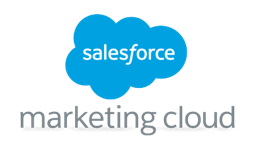
2022 | Salesforce announces sustainability as a core company value (Forbes, 2022). |
2012 |
|
2009 | Salesforce launches Service Cloud, bringing customer service and support automation features to the market (TechCrunch, 2009). |
2003 |
|
2001 |
|
Salesforce is founded in 1999. | |
"Salesforce Marketing Cloud is a long-term juggernaut of the marketing management software space and is the subject of many Info-Tech member inquiries. It retains strong composite and customer experience (CX) scores in our SoftwareReviews reports. Some standout features of the platform include marketing analytics, advanced campaign management functionalities, email marketing automation, and customer journey management capabilities. In recent years Salesforce has made great strides in improving the overall user experience by investing in new product functionalities such as the Einstein What-If Analyzer, which helps test how your next email campaign will impact overall customer engagement, triggers personalized campaign messages based on an individual user's behavior, and uses powerful real-time segmentation and sophisticated AI to deliver contextually relevant experiences that inspire customers to act.
On the downside, we commonly see Salesforce's solutions as costlier than competitors' offerings, and its commercial/sales teams tend to be overly aggressive in marketing its solutions without a distinct link to overarching business requirements. "
Yaz Palanichamy
Senior Research Analyst, Info-Tech Research Group
|
Marketing Cloud Basics |
Marketing Cloud Pro |
Marketing Cloud Corporate |
Marketing Cloud Enterprise |
|---|---|---|---|
|
|
|
"Request a Quote" |
*Pricing correct as of October 2022. Listed in USD and absent discounts. See pricing on vendor's website for latest information.
SoftwareReviews' Enterprise MMS Rankings
Strengths:
- Email Marketing Automation
- Marketing Workflow Management
- Marketing Analytics
Areas to Improve:
- Mobile Marketing Management
- Marketing Operations Management
- Advanced Data Segmentation
history

2022 | SAP announces the second cycle of the 2022 SAP Customer Engagement Initiative. (SAP Community Blog, 2022). |
2020 | SAP acquires Austrian cloud marketing company Emarsys (TechCrunch, 2020). |
2015 | SAP Digital for Customer Engagement launches in May 2015 (SAP News, 2015). |
2009 | SAP begins branching out into three markets of the future (mobile technology, database technology, and cloud). SAP acquires some of its competitors (e.g. Ariba, SuccessFactors, Business Objects) to quickly establish itself as a key player in those areas (SAP, n.d.). |
1999 | SAP responds to the internet and new economy by launching its mysap.com strategy (SAP, n.d.). |
SAP is founded In 1972. | |
"Over the years, SAP has positioned itself as one of the usual suspects across the enterprise applications market. While SAP has a broad range of capabilities within the CRM and customer experience space, it consistently underperforms in many of our user-driven SoftwareReviews reports for MMS and adjacent areas, ranking lower in MMS product feature capabilities such as email marketing automation and advanced campaign management than other mainstream MMS vendors, including Salesforce Marketing Cloud and Adobe Experience Cloud. The SAP Customer Engagement Marketing platform seems decidedly a secondary focus for SAP, behind its more compelling presence across the enterprise resource planning space.
If you are approaching an MMS selection from a greenfield lens and with no legacy vendor baggage for SAP elsewhere, experience suggests that your needs will be better served by a vendor that places greater primacy on the MMS aspect of their portfolio."
Yaz Palanichamy
Senior Research Analyst, Info-Tech Research Group
|
SAP Customer Engagement Marketing pricing is opaque: |
|---|
*Info-Tech recommends reaching out to the vendor's internal sales management team for explicit details on individual pricing plans for the Adobe Marketing Cloud suite.
SoftwareReviews' Enterprise MMS Rankings
Strengths:
- Social Media Automation
- Email Marketing Automation
- Marketing Analytics
Areas to Improve:
- Ease of Data Integration
- Breadth of Features
- Marketing Workflow Management
SoftwareReviews' Enterprise MMS Rankings
Strengths:
- Campaign Management
- Segmentation
- Email Delivery
Areas to Improve:
- Mobile Optimization
- A/B Testing
- Content Authoring
history
![]()
|
2021 |
Zoho announces CRM-Campaigns sync (Zoho Campaigns Community Learning, 2021). |
|
2020 |
Zoho reaches more than 50M customers in January ( Zippia, n.d.). |
|
2017 |
Zoho launches Zoho One, a comprehensive suite of 40+ applications (Zoho Blog, 2017). |
|
2012 |
Zoho releases Zoho Campaigns (Business Wire, 2012). |
|
2007 |
Zoho expands into the collaboration space with the release of Zoho Docs and Zoho Meetings (Zoho, n.d.). |
|
2005 |
Zoho CRM is released (Zoho, n.d.). |
|
Zoho platform is founded in 1996. |
|
"Zoho maintains a long-running repertoire of end-to-end software solutions for business development purposes. In addition to its flagship CRM product, the company also offers Zoho Campaigns, which is an email marketing software platform that enables contextually driven marketing techniques via dynamic personalization, email interactivity, A/B testing, etc. For organizations that already maintain a deep imprint of Zoho solutions, Zoho Campaigns will be a natural extension to their immediate software environment.
Zoho Campaigns is a great ecosystem play in environments that have a material Zoho footprint. In the absence of an existing Zoho environment, it's prudent to consider other affordable products as well."
Yaz Palanichamy
Senior Research Analyst, Info-Tech Research Group
|
Free Version |
Standard |
Professional |
|---|---|---|
|
|
|
*Pricing correct as of October 2022. Listed in USD and absent discounts.
See pricing on vendor's website for latest information.
Leverage Info-Tech's research to plan and execute your MMS implementation
Use Info-Tech's three-phase implementation process to guide your planning:
|
1. Assess |
|---|
|
2. Prepare |
|
3. Govern & Course Correct |
Download Info-Tech's Governance and Management of Enterprise Software Implementation
Establish and execute an end-to-end, agile framework to succeed with the implementation of a major enterprise application.
Ensure your implementation team has a high degree of trust and communication
If external partners are needed, dedicate an internal resource to managing the vendor and partner relationships.
Communication
Teams must have some type of communication strategy. This can be broken into:
- Regularity: Having a set time each day to communicate progress and a set day to conduct retrospectives.
- Ceremonies: Injecting awards and continually emphasizing delivery of value to encourage relationship building and constructive motivation.
- Escalation: Voicing any concerns and having someone responsible for addressing them.
Proximity
Distributed teams create complexity as communication can break down. This can be mitigated by:
- Location: Placing teams in proximity to eliminate the barrier of geographical distance and time zone differences.
- Inclusion: Making a deliberate attempt to pull remote team members into discussions and ceremonies.
- Communication Tools: Having the right technology (e.g. video conference) to help bring teams closer together virtually.
Trust
Members should trust other members are contributing to the project and completing their required tasks on time. Trust can be developed and maintained by:
- Accountability: Having frequent quality reviews and feedback sessions. As work becomes more transparent, people become more accountable.
- Role Clarity: Having a clear definition of what everyone's role is.
Selecting a right-sized MMS platform
This selection guide allows organizations to execute a structured methodology for picking an MMS platform that aligns with their needs. This includes:
- Alignment and prioritization of key business and technology drivers for an MMS selection business case.
- Identification of key use cases and requirements for a right-sized MMS platform.
- A comprehensive market scan of key players in the MMS market space.
This formal MMS selection initiative will drive business-IT alignment, identify pivotal sales and marketing automation priorities, and thereby allow for the rollout of a streamlined MMS platform that is highly likely to satisfy all stakeholder needs.
If you would like additional support, have our analysts guide you through other phases as part of an Info-Tech workshop
contact your account representative for more information
workshops@infotech.com
1-888-670-8889
Summary of accomplishment
Knowledge Gained
- What marketing management is
- Historical origins of marketing management
- The future of marketing management
- Key trends in marketing management suites
Processes Optimized
- Requirements gathering
- RFPs and contract reviews
- Marketing management suite vendor selection
- Marketing management platform implementation
Marketing Management
- Adobe Experience Cloud
- Microsoft Dynamics 365 for Marketing
- HubSpot Marketing Hub
- Maropost Marketing Cloud
- Oracle Marketing Cloud
Vendors Analyzed
- Salesforce Marketing Cloud
- SAP
- Sugar Market
- Zoho Campaigns
Related Info-Tech Research
Select a Marketing Management Suite
Many organizations struggle with taking a systematic approach to selection that pairs functional requirements with specific marketing workflows, and as a result they choose a marketing management suite (MMS) that is not well aligned to their needs, wasting resources and causing end-user frustration.
Customer relationship management (CRM) application portfolios are often messy,
with multiple integration points, distributed data, and limited ongoing end-user training. A properly optimized CRM ecosystem will reduce costs and increase productivity.
Customer Relationship Management Platform Selection Guide
Speed up the process to build your business case and select your CRM solution. Despite the importance of CRM selection and implementation, many organizations struggle to define an approach to picking the right vendor and rolling out the solution in an effective and cost-efficient manner.
Bibliography
"16 Biggest Tech Acquisitions in History." The Economic Times, 28 July 2016. Web.
"Adobe Acquires Demdex – Brings Audience Optimization to $109 Billion Global Online Ad Market." Adobe News, 18 Jan 2011. Accessed Nov 2022.
"Adobe Company History Timeline." Zippia, 9 Sept 2022. Accessed Nov 2022.
"Adobe to acquire Magento for $1.68B." TechCrunch, 21 May 2018. Accessed Dec 2022.
Anderson, Meghan Keaney. "HubSpot Launches European Headquarters." HubSpot Company News, 3 Mar 2013.
Arenas-Gaitán, Jorge, et al. "Complexity of Understanding Consumer Behavior from the Marketing Perspective." Journal of Complexity, vol. 2019, 8 Jan 2019. Accessed Sept 2022.
Bureau of Labor Statistics. "Advertising, Promotions, and Marketing Managers." Occupational Outlook Handbook. U.S. Department of Labor, 8 Sept 2022. Accessed 1 Nov 2022.
"Campaigns." Marketing Hub, HubSpot, n.d. Web.
Conklin, Bob. "Adobe report reveals best marketing practices for B2B growth in 2023 and beyond." Adobe Experience Cloud Blog, 23 Sept 2022. Web.
"Consumer Behavior Stats 2021: The Post-Pandemic Shift in Online Shopping Habit" Nosto.com, 7 April 2022. Accessed Oct 2022.
"Data Collection Overview." Experience League, Adobe.com, n.d. Accessed Dec 2022.
Duduskar, Avinash. "Interview with Tony Chen, CEO at Channel Factory." MarTech Series, 16 June 2017. Accessed Nov 2022.
"Enhanced Release of SAP Digital for Customer Engagement Helps Anyone Go Beyond CRM." SAP News, 8 Dec. 2015. Press release.
Fang, Mingyu. "A Deep Dive into Gucci's Metaverse Practice." Medium.com, 27 Feb 2022. Accessed Oct 2022.
Flanagan, Ellie. "HubSpot Launches Marketing Hub Starter to Give Growing Businesses the Tools They Need to Start Marketing Right." HubSpot Company News, 17 July 2018. Web.
Fleishman, Hannah. "HubStop Announces Pricing of Initial Public Offering." HubSpot Company News, 8 Oct. 204. Web.
Fluckinger, Don. "Adobe to acquire Workfront for $1.5 billion." TechTarget, 10 Nov 2020. Accessed Nov 2022.
Fluckinger, Don. "Microsoft Dynamics 365 adds customer journey orchestration." TechTarget, 2 March 2021. Accessed Nov 2022.
Green Marketing: Explore the Strategy of Green Marketing." Marketing Schools, 19 Nov 2020. Accessed Oct 2022.
Ha, Anthony. "Oracle Announces Its Cross-Platform Marketing Cloud." TechCrunch, 30 April 2014. Web.
Heyd, Kathrin. "Partners Welcome – SAP Customer Engagement Initiative 2022-2 is open for your registration(s)!" SAP Community Blog, 21 June 2022. Accessed Nov 2022.
HubSpot. "Our Story." HubSpot, n.d. Web.
Jackson, Felicia. "Salesforce Tackles Net Zero Credibility As It Adds Sustainability As A Fifth Core Value." Forbes, 16 Feb. 2022. Web.
Kolakowski, Nick. "Salesforce CEO Marc Benioff Talks Social Future." Dice, 19 Sept. 2012. Web.
Lardinois, Frederic. "Microsoft's Q4 earnings beat Street with $22.6B in revenue, $0.69 EPS." TechCrunch, 19 July 2016. Web.
Levine, Barry. "G2 Crowd report finds the two email marketing tools with the highest user satisfaction." Venture Beat, 30 July 2015. Accessed Nov 2022.
Looking Back, Moving Forward: The Evolution of Maropost for Marketing." Maropost Blog, 21 May 2019. Accessed Oct 2022.
Maher, Sarah. "What's new with HubSpot? Inbound 2022 Feature Releases." Six & Flow, 9 July 2022. Accessed Oct 2022.
Marketing Automation Provider, Salesfusion, Continues to Help Marketers Achieve Their Goals With Enhanced User Interface and Powerful Email Designer Updates." Yahoo Finance, 10 Dec 2013. Accessed Oct 2022.
"Maropost Acquires Retail Express for $55 Million+ as it Continues to Dominate the Global Commerce Space." Marapost Newsroom, PRWire.com, 19 Jan 2022. Accessed Nov 2022.
McDowell, Maghan. "Inside Gucci and Roblox's new virtual world." Vogue Business, 17 May 2021. Web.
Miller, Ron. "Adobe and Microsoft expand partnership with Adobe Experience Manager and Dynamics 265 Integration." TechCrunch, 3 Nov 2017. Accessed Nov 2022.
Miller, Ron. "Adobe to acquire Magento for $1.68B" TechCrunch, 21 May 2018. Accessed Nov 2022.
Miller, Ron. "SAP continues to build out customer experience business with Emarys acquisition." TechCrunch, 1 Oct. 2020. Web.
Miller, Ron. "SugarCRM moves into marketing automation with Salesfusion acquisition." TechCrunch, 16 May 2019.
Novet, Jordan. "Adobe confirms it's buying Marketo for $4.75 billion." CNBC, 20 Sept 2018. Accessed Dec 2022.
"Oracle Corp." Encyclopedia.com, n.d. Web.
Phillips, James. "April 2019 Release launches with new AI, mixed reality, and 350+ feature updates." Microsoft Dynamics 365 Blog. Microsoft, 2 April 2019. Web.
S., Aravindhan. "Announcing an important update to Zoho CRM-Zoho Campaigns integration." Zoho Campaigns Community Learning, Zoho, 1 Dec. 2021. Web.
Salesforce. "The History of Salesforce." Salesforce, 19 March 2020. Web.
"Salesfusion Integrates With NetSuite CRM to Simplify Sales and Marketing Alignment" GlobeNewswire, 6 May 2016. Accessed Oct 2022. Press release.
"Salesfusion Integrates With NetSuite CRM to Simplify Sales and Marketing Alignment." Marketwired, 6 May 2016. Web.
"Salesfusion is Now Sugar Market: The Customer FAQ." SugarCRM Blog, 31 July 2019. Web.
"Salesfusion's Marketing Automation Platform Drives Awareness and ROI for Education Technology Provider" GlobeNewswire, 25 June 2015. Accessed Nov 2022. Press release.
SAP. "SAP History." SAP, n.d. Web.
"State of Marketing." 5th Edition, Salesforce, 15 Jan 2019. Accessed Oct 2022.
"Success selects Maropost Marketing Cloud for Marketing Automation." Apps Run The World, 10 Jan 2015. Accessed Nov 2022.
"SugarCRM Acquires SaaS Marketing Automation Innovator Salesfusion." SugarCRM, 16 May 2019. Press release.
Sundaram, Vijay. "Introducing Zoho One." Zoho Blog, 25 July 2017. Web.
"The State of MarTech: Is you MarTech stack working for you?" American Marketing Association, 29 Nov 2021. Accessed Oct 2022.
"Top Marketing Automation Statistics for 2022." Oracle, 15 Jan 2022. Accessed Oct 2022.
Trefis Team. "Oracle Energizes Its Marketing Cloud With New Features." Forbes, 7 April 2015. Accessed Oct 2022.
Vivek, Kumar, et al. "Microsoft Dynamics 365 Customer Engagement (on-premises) Help, version 9.x." Learn Dynamics 365, Microsoft, 9 Jan 2023. Web.
"What's new with HubSpot? Inbound 2022 feature releases" Six and Flow, 9 July 2022. Accessed Nov 2022.
Widman, Jeff. "Salesforce.com Launches The Service Cloud,, A Customer Service SaaS Application." TechCrunch, 15 Jan. 2009. Web.
"Zoho History." Zippia, n.d. Web.
"Zoho Launches Zoho Campaigns." Business Wire, 14 Aug. 2012. Press release.
Zoho. "About Us." Zoho, n.d. Web.
Need hands-on assistance?
Engage Info-Tech for a Software Selection Workshop!
40 Hours of Advisory Assistance Delivered On-Line or In-Person
Select Better Software, Faster.
40 Hours of Expert Analyst Guidance
Project & Stakeholder Management Assistance
Save money, align stakeholders, Speed up the process & make better decisions.
Better, faster results, guaranteed, $25K standard engagement fee

CLICK HERE to book your Workshop Engagement

